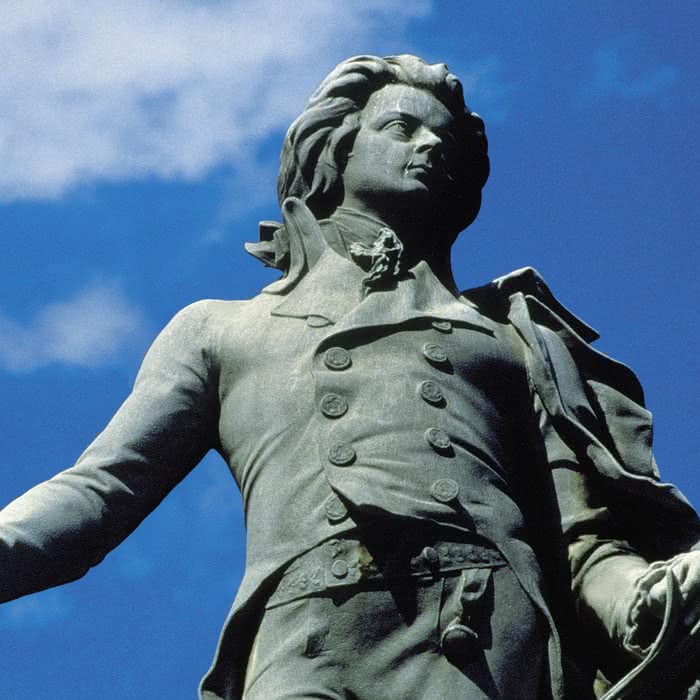I first encountered Mozart’s last mass, the incomplete C minor “K427”, in college in the 1960s and bought the record conducted by Ferdinand Grossmann. I liked it, listened a few times, and got on with life. I discovered it again in April, 2000, while making cassette tapes out of records (ah, those were the days!) and became curious as to how the missing sections might have been filled in (if they even were) for the one and only performance in Mozart’s lifetime. The liner notes suggested he might have used parts of his first mass, “K139”, also in C minor.
Cheapskate that I am, I found a CD of “K139” conducted by Marcus Creed for only $3.99 and bought it. I found it rather agreeable, and after listening to it several times, it turned into a gateway drug. I sent for the complete set of masses on Philips. By the beginning of May I had listened to them all.
I wrote to my friend Sandy, “The Mozart masses, though unnecessary listening except for ‘K427’ and the ‘Requiem’, are interesting both individually and as a group and allow one to see him struggle with the authority of the hated archbishop and with the desire to produce both well-constructed and listenable music” (my prose has improved since then).
I began listening to them nonstop in my car on what was a 90-minute commute each way to work. The total running time for the sixteen “Salzburg” masses plus “K427” is just over 427 minutes (oh, I like that!). That’s over 8 listens for each mass over the next four weeks, when I wrote in follow-up, “I’m in love with the masses”.
I bought all the scores. I bought the Teldec and the Brilliant Classics complete CD sets. By November, I wrote, “I continue to listen almost constantly to the sixteen masses in my car. It’s amazing that I still don’t feel I know them well enough to write my next ‘Steve’s Folly’ essay. But it’s inevitable if I live long enough”.
By January of 2001, I was listening to single mass movements over and over and dictating random comments into a cassette recorder while driving. By June I had “done” 5 masses.

My last note to her on the subject was in August, 2001: “It’s a scary commentary on my obsession that one of my earliest comments to you was that the masses, except for ‘K427’ and the ‘Requiem’, were pleasant enough listening but ‘hardly essential’ and that now I consider them the only music worth listening to. I remember making disparaging comments especially about ‘K262’, his longest complete non-cantata mass, saying it was perhaps the only true dud in the bunch. That’s the one I’m studying right now and my current opinion is that it’s amazing, wonderful, and so on, with one marvelous melody after another. Well, I never claimed to be objective, now did I?”
My correspondence fell off as I became preoccupied with work, having been fired from my job as medical director of the smaller mental health agency in a merger, and I have no idea when I finished dictation, as I did not date the cassettes. At the above rate, maybe another year. I then transcribed the often incomprehensible comments and have been writing at them off and on ever since.
I did not keep very good track of when first drafts were finished, but the ones I did date suggest they were coherent enough to have their hyperlinks to musical examples by then.
Once I was able to describe to my satisfaction what I hear in Mozart’s masses and accompany the words with musical examples, the last task has been to place the comments in a continuous narrative in chronological order by mass and see what the music might have had to do with his relationships.
The behemoth that has emerged is called “A Listener’s Guide to the Masses of Mozart.” It is structured as a series of sequential Microsoft Word document folders to aid in a reader’s orientation, as in its entirety it runs over two hundred pages. It can really only be read electronically due to the many hyperlinks to musical snippets, so it does not exist in a print version.
Sung masses earlier than about the end of the seventeenth century were generally without instrumental accompaniment or perhaps used just an organ. In the discussions that follow, I’ll take us through about 80 years of the background of concerted (orchestrally accompanied) masses in the Western Europe into which Mozart was born. We’ll look at a couple of immediate precursors by his father and then dive into “the only music worth listening to.”
“Well, I never claimed to be objective, now did I?”
–05/13/2019
![]()

